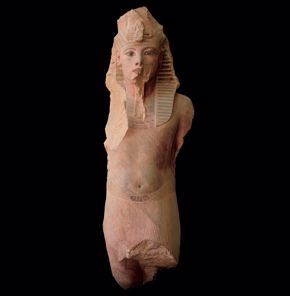Tutankhamun: The Golden King and the Great Pharaohs October 15, 2011–April 14, 2012

Colossal Statue of Tutankhamun, 18th dynasty, painted quartzite. © Sandro Vannini
Falcon Collar of the Princess Neferuptah, 12th dynasty, gold, carnelian, and feldspar. © Sandro Vannini
Funerary Mask of Psusennes I, 21st dynasty, gold, lapis lazuli, and glass paste.
Head of Amenhotep III in the Blue Crown, 18th dynasty, painted clay and stucco. © Sandro Vannini
Leopard-Head Decoration from a Ritual Robe, 18th dynasty, gilded wood, rock crystal, and colored glass.
Box with Cartouches of Amenhotep III, 18th dynasty, wood and faience. © Sandro Vannini
Canopic Coffinette from Tutankhamun’s Tomb (detail), 18th dynasty, gold, carnelian, obsidian, and rock crystal. © Sandro Vannini
Canopic Coffinette from Tutankhamun's Tomb (detail), 18th dynasty, gold, carnelian, and colored glass. © Sandro Vannini
Colossal Statue of Amenhotep IV / Akhenaten in Nemes and Double Crown, 18th Dynasty, sandstone, Egyptian Supreme Council of Antiquities. © Sandro Vannini
Pair of Sandals found on Tutankhamun’s Mummy, 18th Dynasty, gold, Egyptian Supreme Council of Antiquities. © Sandro Vannini
The acclaimed traveling exhibition Tutankhamun: The Golden King and the Great Pharaohs features more than 100 works of art, most of which had never been shown in the United States prior to this tour. These spectacular treasures—about half of which come from the tomb of King Tutankhamun—include the golden sandals found on the boy king’s mummy; a gold coffinette that held his stomach; golden statues of the gods; and King Tut’s rings, ear ornaments, and gold collar.
Also showcased are objects associated with the most-important rulers of the 30 dynasties that reigned in Egypt over a 2,000-year span. The exhibition explores the splendor of the pharaohs, their function in both the earthly and divine worlds, and what “kingship” meant to the Egyptian people. Among the highlights is the largest likeness of King Tut ever discovered: a 10-foot statue of the pharaoh found at the remains of a funerary temple.

